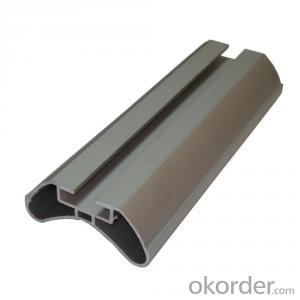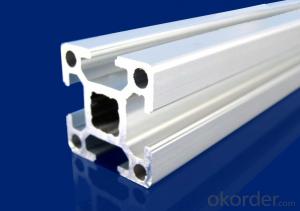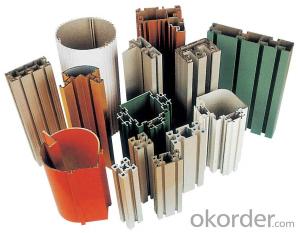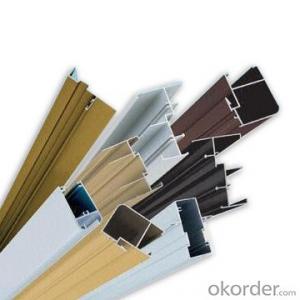Alumunum profile extrusion 6061
- Loading Port:
- China Main Port
- Payment Terms:
- TT OR LC
- Min Order Qty:
- -
- Supply Capability:
- -
OKorder Service Pledge
OKorder Financial Service
You Might Also Like
Aluminium is a relatively soft, durable, lightweight, ductileand malleablemetalwith appearance ranging from silvery to dull gray, depending on the surfaceroughness. It is nonmagnetic and does not easily ignite. A fresh film ofaluminium serves as a good reflector (approximately 92%) of visible lightand an excellent reflector (as much as 98%) of medium and far infraredradiation. The yield strength of pure aluminium is 7–11 MPa,while aluminium alloys have yield strengths ranging from200 MPa to 600 MPa. Aluminium has about one-third the densityand stiffness of steel. It is easily machined,cast, drawn and extruded.
Aluminium alloys (or aluminum alloys; see spellingdifferences) are alloysin which aluminium(Al) is the predominant metal. The typical alloying elements are copper, magnesium,manganese,silicon,tin and zinc. There are twoprincipal classifications, namely casting alloys and wrought alloys, both of which are furthersubdivided into the categories heat-treatableand non-heat-treatable. About 85% of aluminium is used for wrought products,for example rolled plate, foils and extrusions.Cast aluminium alloys yield cost-effective products due to the low meltingpoint, although they generally have lower tensile strengthsthan wrought alloys. The most important cast aluminium alloy system is Al–Si,where the high levels of silicon (4.0–13%) contribute to give good castingcharacteristics. Aluminium alloys are widely used in engineering structures andcomponents where light weight or corrosion resistance is required
Features:
Material | Alloy 6063,6061,6005or according to customer’s choice |
Temper | T3, T4, T5, T6 |
Surface | Anodize, electrophoresis, powder coating, PVDF coating, wood grain painting, matted, etc. |
Length | Coating 6.5 meters, Anodizing 6.5 meters, Mill finish 5 meters |
Application | Industrial, electrical equipment(TV set, air conditioner, refrigerator, computer), decoration,construction, transportation |
Custom Made | We can package following with customer's request. |
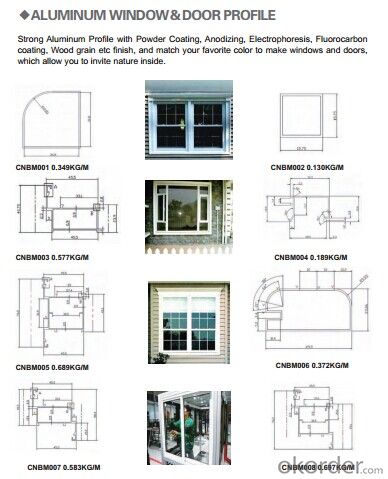


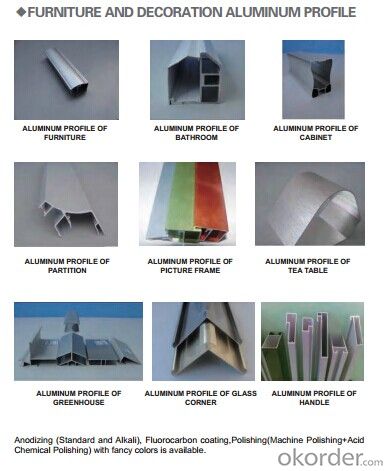
FAQ:
1. What is the form of payment?
Normally 30% TT, L/C at sight
2. Type of quotation?
FOB, CFR, CIF
3. Port of loading?
Shenzhen/Guangzhou port
4. Delivery time?
15-20 days after client’s deposit
- Q:Can aluminum profiles be used for framing mirrors?
- Indeed, mirrors can be framed using aluminum profiles. Aluminum, a lightweight and versatile material, lends a contemporary and polished appearance to any mirror frame. Its durability, resistance to corrosion, and simplicity in customization make it a favored choice in diverse industries such as architecture and interior design. With an array of shapes and finishes available, aluminum profiles provide limitless design options to suit various styles and decorations. Furthermore, the ease of installation and maintenance of aluminum frames further contributes to their popularity in both residential and commercial settings for framing mirrors.
- Q:I have a disinfection cabinet to cut off a piece of aluminum to install the control board, how to cut? What tool to cut?
- The use of wire saw can be sawed, if you cannot use a wire saw, it can only be used to drill holes along the need the position of the drill hole, finally use a tool to trim it to the edge.
- Q:What are the cost considerations for using aluminum profiles?
- Some cost considerations for using aluminum profiles include the initial cost of purchasing the profiles themselves, any additional costs for custom or specialized profiles, the cost of installation and assembly, maintenance costs, and potential future costs for repairs or replacements. Additionally, the cost of aluminum profiles may vary depending on the quality and thickness of the material used.
- Q:Can aluminum profiles be used for solar panel installations?
- Yes, aluminum profiles can be used for solar panel installations. Aluminum is a commonly used material in the construction industry due to its lightweight, durability, and resistance to corrosion. These characteristics make it an ideal choice for supporting and mounting solar panels. Aluminum profiles can be easily fabricated and customized to fit specific installation requirements, such as roof or ground mounting systems. Moreover, aluminum has excellent thermal conductivity, allowing for efficient heat dissipation from the solar panels, which is crucial for maintaining their performance and lifespan. Additionally, aluminum profiles are often used for framing solar panels, providing structural support and ensuring their stability in various weather conditions. Overall, aluminum profiles are a popular choice for solar panel installations due to their strength, longevity, and adaptability.
- Q:Does aluminum alloy profile conduct electricity?
- Aluminum conducts well, and aluminium alloys must also be electrically conductive. But aluminum alloys contain impurities such as silicon and magnesium
- Q:Can aluminum profiles be used in the construction of data centers?
- Yes, aluminum profiles can be used in the construction of data centers. Aluminum profiles have several advantages that make them suitable for use in this industry. Firstly, aluminum is lightweight yet strong, making it an ideal material for constructing structures that need to support heavy loads. Data centers often house racks of servers and other equipment, so using aluminum profiles can provide the necessary strength without adding excessive weight. Secondly, aluminum profiles are highly customizable and can be easily fabricated to meet specific design requirements. This flexibility allows for efficient use of space within a data center, as the profiles can be tailored to fit the layout and dimensions of the facility. Additionally, aluminum is resistant to corrosion, which is crucial in a data center environment where equipment generates heat and humidity levels can be high. By using aluminum profiles, the risk of rust and corrosion is minimized, ensuring the longevity and reliability of the infrastructure. Furthermore, aluminum is a sustainable and recyclable material, which aligns with the growing demand for environmentally friendly construction practices. Using aluminum profiles in data center construction contributes to reducing the carbon footprint of the facility. In summary, aluminum profiles can indeed be used in the construction of data centers due to their strength, customization capabilities, resistance to corrosion, and sustainability.
- Q:How do I install aluminum profiles?
- Follow these steps to install aluminum profiles: 1. Begin by selecting the desired location for the aluminum profile installation and ensure the surface is clean and debris-free. 2. Precisely and smoothly cut the aluminum profile to the required length using a saw or miter saw. 3. Create pilot holes at regular intervals along the marked installation area using a drill. These holes will serve as anchor points for the screws or bolts that will secure the aluminum profile. 4. Align the pilot holes on the aluminum profile with the corresponding holes on the surface. Insert screws or bolts through the holes and tighten them using a screwdriver or socket wrench. 5. If you are installing multiple aluminum profiles, repeat the process for each section, ensuring they are aligned and securely fastened. 6. Once all profiles are installed, inspect for any gaps or unevenness. Adjust and tighten the screws or bolts as necessary to ensure a snug fit. 7. Lastly, clean the installed aluminum profiles using a mild cleaning solution and soft cloth to remove any dirt or residue. Remember to wear appropriate safety gear, such as gloves and safety glasses, when handling tools and materials during the installation process.
- Q:Can aluminum profiles be recycled indefinitely?
- Yes, aluminum profiles can be recycled indefinitely. Unlike other materials, aluminum does not degrade during the recycling process. It can be melted down and reshaped into new profiles without losing its inherent properties. This essentially means that aluminum profiles have a never-ending life cycle. Recycling aluminum requires significantly less energy and resources compared to producing new aluminum, making it an environmentally sustainable option. Moreover, the recycling process can be repeated countless times without any loss in quality, making aluminum one of the most recycled materials in the world.
- Q:Are aluminum profiles suitable for fencing and gates?
- Yes, aluminum profiles are suitable for fencing and gates. Aluminum is a popular choice for these applications due to its durability, strength, and low maintenance requirements. It is resistant to rust, corrosion, and weathering, making it an excellent choice for outdoor use. Additionally, aluminum profiles offer versatility in terms of design, allowing for various styles and customization options. They are lightweight yet sturdy, making them easy to install and handle. Furthermore, aluminum is a sustainable and environmentally friendly material, as it is 100% recyclable. Overall, aluminum profiles provide a practical and aesthetically pleasing solution for fencing and gates.
- Q:How much is the 5000 ton aluminum profile extrusion machine? What section can I have?
- 5000 tons press, plus auxiliary machine, installed finished, almost 50 million -1 million, this depends on the configuration. Cheap certainly also domestic, but a penny a cent goods.A general can reach the maximum about 400mm.
1. Manufacturer Overview |
|
|---|---|
| Location | |
| Year Established | |
| Annual Output Value | |
| Main Markets | |
| Company Certifications | |
2. Manufacturer Certificates |
|
|---|---|
| a) Certification Name | |
| Range | |
| Reference | |
| Validity Period | |
3. Manufacturer Capability |
|
|---|---|
| a)Trade Capacity | |
| Nearest Port | |
| Export Percentage | |
| No.of Employees in Trade Department | |
| Language Spoken: | |
| b)Factory Information | |
| Factory Size: | |
| No. of Production Lines | |
| Contract Manufacturing | |
| Product Price Range | |
Send your message to us
Alumunum profile extrusion 6061
- Loading Port:
- China Main Port
- Payment Terms:
- TT OR LC
- Min Order Qty:
- -
- Supply Capability:
- -
OKorder Service Pledge
OKorder Financial Service
Similar products
New products
Hot products
Hot Searches
Related keywords
